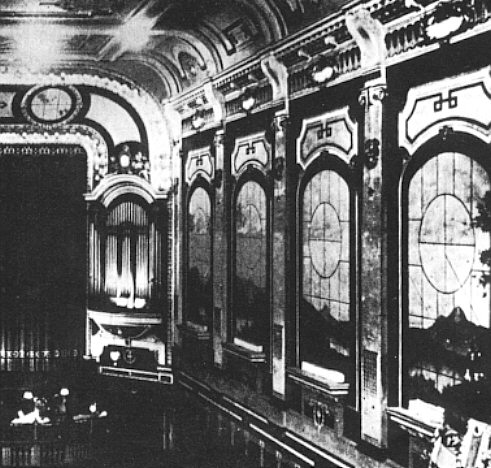
Back to Main Encylopaedia Contents
De Luxe Theatre, Melbourne
Melbourne's De Luxe Theatre shares with the Regent Theatre, Melbourne and the Victory Theatre in the Sydney suburb of Kogarah the distinction of having housed three pipe organs. The De Luxe initially housed a photoplayer, then a seven-rank Wurlitzer, then an eight-rank Christie. The Victory, on the other hand, started with a photoplayer, then a seven-rank Christie, followed by an eight-rank Wurlitzer!
Hoyt's De Luxe Theatre was built in 1914 and 1915 on the site of St. George's Hall in Melbourne's Bourke Street, a site not lacking in cinema history, for it was at St. George's Hall that Arthur Russell commenced showing films in 1908, marking the start of Hoyt's Pictures.[Thorne, Ross, Cinemas of Australia via USA, Architecture Department, Sydney University, 1981, p. 135.] The De Luxe, which opened in April, 1915, seated 2000, the architect being William Pitt. ["Hoyt's Pictures - New Theatre Building", The Argus, 12 November, 1914}
The luxurious appointments and bright surroundings of Hoyt's beautiful picture palace in Bourke Street are much appreciated by patrons, for such comfort most surely conduces to the enjoyment and enhances the pleasure in a very appreciable way. There is a pleasant sense of airiness and spaciousness and comfort that is quite refreshing.
Table Talk, 15 April, 1915, p. 25..

The auditorium decoration was unusual in that the side walls were decorated with trompe l'oeuil windows framing landscape scenes. This, no doubt, contributed to the general effect of spaciousness described above.
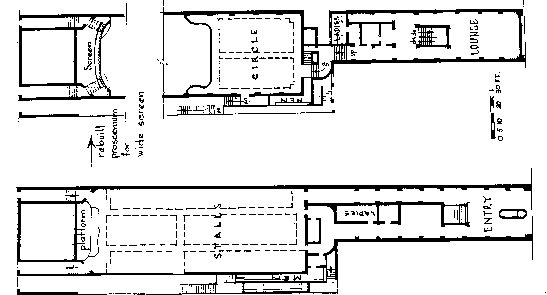
In the theatre was installed a Fotoplayer built by the American Photoplayer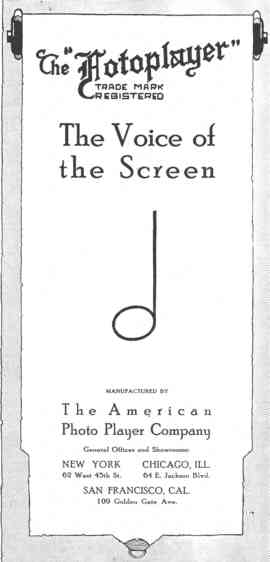 Company. Whether this was present at the opening
of the theatre is not known; it was most likely a later
addition. It was such a large and expensive
instrument that it would almost certainly have
attracted comment at the time, had it been there for
the opening.
Company. Whether this was present at the opening
of the theatre is not known; it was most likely a later
addition. It was such a large and expensive
instrument that it would almost certainly have
attracted comment at the time, had it been there for
the opening.
The Fotoplayer was a Style 50. This was the largest standard model Fotoplayer, comprising a central piano unit flanked by two large cabinets containing 412 pipes and a huge range of traps and effects. The whole contraption was five feet eight inches deep and twenty-one feet long; with one or more cabinets of music rolls, it would have completely filled the orchestra pit, which was approximately thirty feet wide.
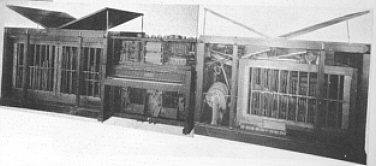
A Style 50 Fotoplayer with the cabinet fronts removed
The seven ranks of pipes were mostly divided between the bass and treble halves of the keyboard, some ranks being available only in the treble, the overall pipe range being 65 notes . There were also 195 harmonium-type reeds, distributed between three treble stops and three bass stops, again over a compass of 65 notes. The full specification of the instrument shows that it included Orchestral Bells (31 notes), Chimes (5 notes) and a Xylophone, plus no less than twenty-six traps and effects. Like all photoplayers, it was fitted with twin roll-players, and although it was capable of being played manually from its single keyboard, the operator's main activity would have been to manipulate the rocking tablets to change stops and to pull cords and press pedals to operate the effects. One can well imagine that in the hands of a skilled operator, such an instrument would provide dramatic enhancement to any silent film.
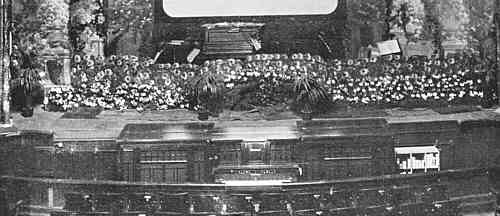
A typical Fotoplayer installation
Unfortunately, no details have so far come to light of the names of any organists who played the De Luxe Fotoplayer, which is believed to have remained in use until 1922. It was then removed, and was installed briefly in Hoyt's theatres in Canterbury, Richmond and other Melbourne suburbs, until in approximately 1926 it was sold to the GlenelgTheatre in the Adelaide resort of Glenelg, where its subsequent story may be found.
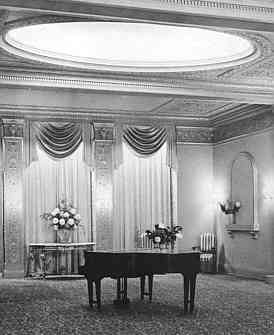
Circle lobby
Photo: Ross Thorne - Picture Palace Architecture in Australia
By the early 1920s, a more sophisticated instrument was deemed necessary to reflect the status of Hoyt's main Melbourne theatre. A two-manual, seven-rank Style 185 instrument had left the Wurlitzer factory on 25 October, 1920. It was installed in the De Luxe, on one side of the proscenium, behind a dummy fašade of diapason pipes, with a matching fašade on the other side. The De Luxe was the only theatre in Australia to feature display pipes in the auditorium, but several early American Wurlitzer installations were similar. The console was on a raised platform at the left-hand side of the auditorium, beneath the display pipes. A separate roll-player console was also installed.
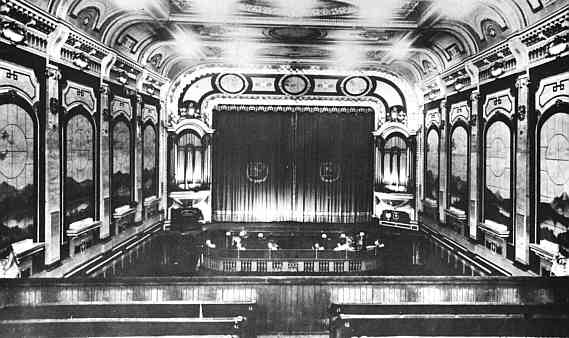
Photo: Ross Thorne - Picture Palace Architecture in Australia
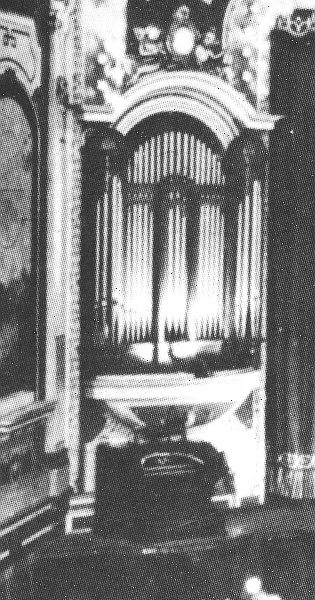 The organ was inaugurated on 12 June, 1922,
by Horace Weber:
The organ was inaugurated on 12 June, 1922,
by Horace Weber:
The new Hope-Jones Unit Orchestra was used for the first public performance on Monday last, when the soloist was Horace G Weber. It is a wonderful musical combination and a welcome addition to Hoyt's De Luxe.
Everyone's, Sydney, 21 June, 1922
Its success was re-iterated a couple of months later:
A Fine Orchestrelle
One of the marvels of the musical instrument world is undoubtedly the cleverly constructed orchestr-elle at Hoyt's Theatre De Luxe, Melbourne. It is an Hope-Jones instrument and said to equal the best yet installed in Australia. Furthermore the firm is fortunate in having an excellent musician in Horace G Weber, a gentleman who knows the instrument thoroughly and delights his large audience every night by his masterly renditions on the instrument.
Everyone's, Sydney, 9 August, 1922
The De Luxe organ was the first horseshoe-console Wurlitzer to be installed in an Australian theatre. It was Opus 359, and comprised seven ranks of pipes: Tuba Horn, Diaphonic Diapason, Clarinet, Viol, Viol CÚleste, Concert Flute and Vox Humana. These ranks, plus the percussions and traps, were installed in a single chamber, probably behind the display pipes in the former decorative box on the left-hand side of the proscenium. One other Style 185 organ was installed in Australia, at the Wintergarden Theatre in Brisbane, in 1924. That instrument, which featured a separate echo chamber, is described in detail elsewhere.
The choice of an Australian organist to open the new Wurlitzer is worthy of special note. It was a remarkable tribute to Horace Weber's skills that he was the only Australian organist to open a horseshoe-console Wurlitzer new from America. All the others (except for the Capitol, Melbourne, which Weber also inaugurated) were opened by American organists who came with the organs as part of the contract arrangement, and remained for varying lengths of time to train Australian organists to play them.
Horace Weber had spent some four years playing an enlarged Wurlitzer photoplayer at the Grand Theatre in Adelaide, and must have convinced the Wurlitzer Company that he had the requisite skills and experience to do justice to the De Luxe organ. It was no doubt his success at the De Luxe which paved the way for the many Wurlitzer organs which were to follow for Hoyt's and other circuits.
Horace Weber remained at the De Luxe for just over two years, leaving to open Australia's first large Wurlitzer, at Melbourne's Capitol Theatre, in August, 1924.
Details of organists who followed him at the De Luxe have not so far come to light. The Wurlitzer organ remained there until 1927, when it was removed to the Paramount Theatre in Melbourne.
In January, 1928, Signor Kost's Italian orchestra was performing at the De Luxe, prior to opening at the Regent, Sydney, in March, 1928. [Everyone's, Sydney, 25 January, 1928, p. 6.] It was also announced in September, 1928, that organist Roy Devany had left the Regent, Perth, for the De Luxe, Melbourne. [Everyone's, Sydney, 26 September, 1928] This is somewhat surprising, as there was no organ installed at that time. However, Devany had distinguished himself at Perth by directing an orchestra pending the completion of its Wurlitzer organ, so perhaps he directed an orchestra at the De Luxe.
In July, 1929, a Christie organ which had been briefly installed in Perth a year previously was opened by Charles Tuckwell. [Cork, Kevin J., A History of the Organs of Sydney's Suburban Cinemas, Sydney, 1988, p.17] This organ was Christie's Opus 2720, with two manuals and eight ranks of pipes (Tuba, Tibia Clausa, Open Diapason, Clarinette, Flute, Viole d'Orchestre, Voix CÚleste and Vox Humana).
The Christie was not destined to remain very long, as in April, 1930, it had moved again, being opened at the new Plaza Theatre in Sydney, by American organist Eddie Fitch. No organist other than Charles Tuckwell is recorded as having played it in Melbourne, and it is likely that its time there would have corresponded with a six-month engagement for Tuckwell.
At this point in history, one can only speculate as to why it was installed for such a short period. Possibly the arrival of sound films and the halving in size and cost of the original plans for the Plaza caused Hoyt's to cancel any plans they might have had to install a new organ at the Plaza. They may have decided instead to save costs by moving the Christie from Melbourne. It is unlikely that it was originally intended that it should be at Melbourne for just a few months, as the installation costs would not have justified this.
As it was, it was not only the sole Christie organ installed in a Melbourne theatre (which is perhaps somewhat surprising, given the location of Hill, Norman and Beard's factory there), but was the final organ to be installed in any Melbourne theatre until the 1960s.
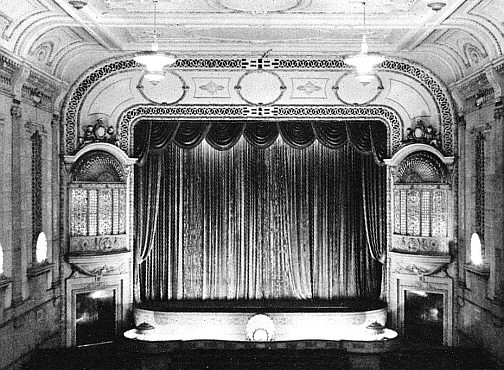
The De Luxe in the 1930s
Photo: Ross Thorne - Cinemas of Australia via USA
The De Luxe, now without an organ, was modified internally, particularly as regards the proscenium and stage area, in 1934. [Thorne, Ross, Cinemas of Australia via USA, p. 135] .After the Second World War it was renamed Hoyt's Esquire Theatre, in which guise it survived until it closed in March, 1976, to provide room for expansion of G J Cole's store. ["Hoyt's Esquire Closing", Vox, TOSA Melbourne, March, 1976, p. 9].